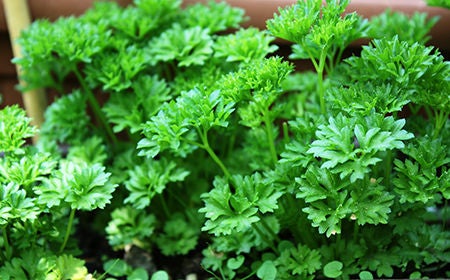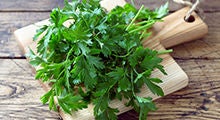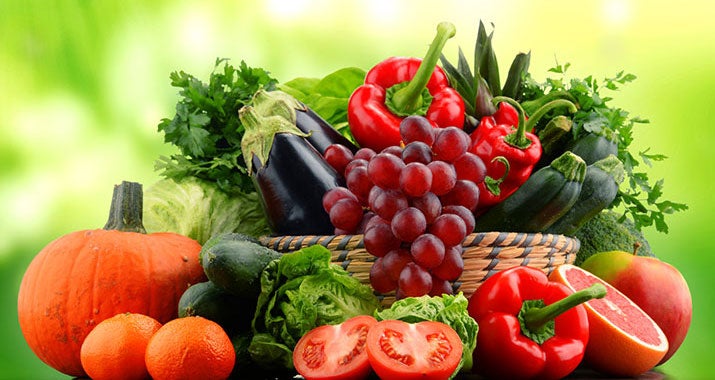
Petroselinum crispum
Parsley is a popular herb, gracing many meals as either a garnish or ingredient. It is fairly easy to grow, although it is a biennial, meaning it only lives two years. The first year is the best year to harvest the leaves. The second year is when the parsley flowers, producing seeds to save and grow the following year.
The leaves can be curly or flat, the latter known as Italian parsley. On both types of leaves, clusters of small green-yellow flowers grow in umbels. This is true of all plants in the family, which some call the Parsley Family and others call the Carrot Family.
In addition to being useful in the kitchen, parsley is also an attractive addition to the garden, especially curly parsley with its bushy growth. Grow parsley in the veggie garden in rows or clumps, but also consider including some in between flowers in containers or flower beds.
GROWING
Parsley can be slow to start from seed, but you can speed up the process by soaking seeds overnight. Plant indoors two to three months before the last frost to get a head start on the season. Otherwise, plant seeds directly outside three to four weeks before the last spring frost. Parsley is quite versatile and can grow in full sun or partial shade. As with many garden plants, fertilize it with compost during the growing season by working some into the soil before you plant. You can supplement with compost tea during the summer.
You can harvest the leaves at the end of the year and keep the root in the ground for next year when it will flower, providing food for some of our smaller pollinators and then seeds for you!
HARVESTING AND STORING

Harvest parsley during the summer by snipping stems as you need them. Try to take the outer leaves to allow the centre of the plant to continue growing.
If you have lots of parsley left by the time winter frosts are looming, cut the whole lot and store it in the freezer. You can do this by chopping up the parsley and putting small amounts in ice cube trays, covered with a bit of olive oil. Once frozen, you can remove the cubes from the tray and store them in a Tupperware container in the freezer. Alternatively, you can tightly roll the stems in Saran Wrap or a reusable plastic sandwich bag. Squeeze the air out, seal the bag and freeze. As you need parsley, you can either take a pre-chopped cube or cut a segment off the parsley roll.
USES
Parsley is used to garnish many dishes, from soups to salads. It is also the main ingredient in a Middle Eastern salad called tabbouleh.
In addition to being tasty, parsley is also highly nutritious – it includes antioxidants; vitamins C, A and K; and many minerals, such as iron and calcium. In fact, it’s believed to have more iron than spinach and more vitamin C than oranges!

Black Swallowtail and Anise Swallowtail butterflies are known to eat parsley. If you have these butterfly species in your area, consider growing extra plants to help them and to enjoy their presence as they become butterflies.
- 0
- 1


